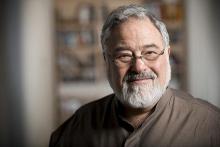What Is It
An increasing number of psychologists and philosophers believe that to understand how the mind really works, we must understand it as both embedded in a body and as situated in an environment. According to some, in fact, the body and the environment do not just house the mind, but are an essential part of the mind in the sense that workings of the mind depend upon and exploit the body and the environment. John and Ken probe the extended mind, embodied cognition, and the situated self with renowned cognitive scientist George Lakoff, co-author of Philosophy in the Flesh: The Embodied Mind and Its Challenge to Western Thought. This program was recorded in front a live audience at the Marsh Theater in Berkeley, California.
Listening Notes
John and Ken start off the show by trying to puzzle through locating the mind in space. John takes the conservative position of the mind’s location as being between the two ears, but Ken begs to differ; he insists that the mind is more closely tied to the body and to the external environment than one might initially think. He demonstrates this by asking John to reach for a glass of water. If the mind is whatever is responsible for movement, and the brain was only partly responsible in tandem with the mechanics of the hand, Ken reasons, then the mind’s location must not simply be the same as the brain’s location.
John and Ken continue the discussion with George Lakoff, professor of Linguistics at UC Berkeley, to further explore the concept of the “extended mind.” Barring some terminological confusion between Andy Clarke’s “extended mind,” John Barwise’s “situated cognition,” and Lakoff’s own preferred “embodied mind,” the conversation turns toward examples of how integral the body and environment is to how we think. Lakoff starts by explaining how color is only perceived by humans because of the biological structure of cones on our retinas and the neural circuitry in our brains; there is no color in the world, just wavelengths reflected by objects. Even our conception of thought itself relies on the body’s interaction with environment: we “reach” conclusions and “digest” ideas. Such metaphors, George insists, constitute our ideas of what thought is, so there could be no such thought without embodiment.
In the latter portion of the show, George, John, and Ken field questions from the audience ranging from the nature of perception as exclusively an active process to cognitive dissonance and the ignoring of facts that don’t fit into pre-existing conceptual frameworks. In addition, Ken shares his thoughts on how the brain is designed to offload information onto the external world to decrease computational workload. He gives the example of physically scrambling Scrabble letters rather than mentally running through permutations. George supports this claim by pointing out that the brain contains a “best fit” mechanism for solving problems in the most efficient way possible. John humorously concludes the show with a statement of appreciation for his possession of a mind.
- Roving Philosophical Reporter (Seek to 6:10) : In an interview with Jaron Lanier, the “father of virtual reality,” Caitlin Esch explores how minds are able to learn to control avatars, whether these avatars be lobsters, dinosaurs, or even molecules. The segment ends with a provocative question: if we can change the way we think, might we be prompted to think something completely new?
- 60-Second Philosopher (Seek to 48:36) : Ian Shoales discusses the Atlantic article “Is Google Making Us Stupid?” by Nicholas Carr. He bemoans the days when he could win bar bets without the intervention of smart phone knowledge and when people knew how to read maps instead of blindly trusting their GPS.



